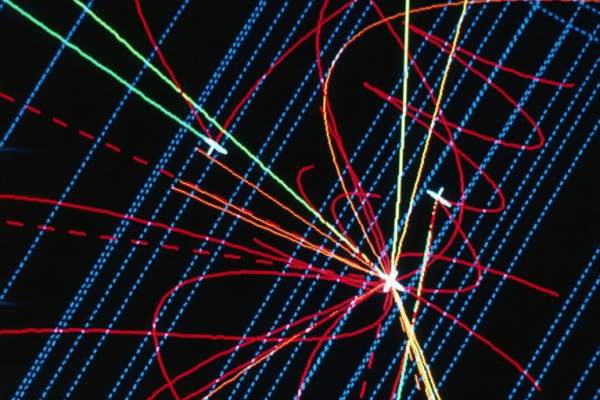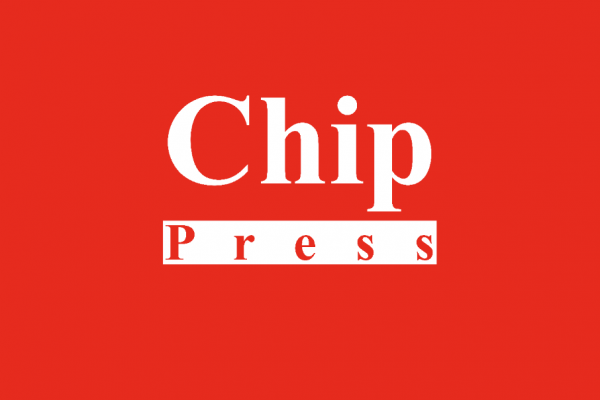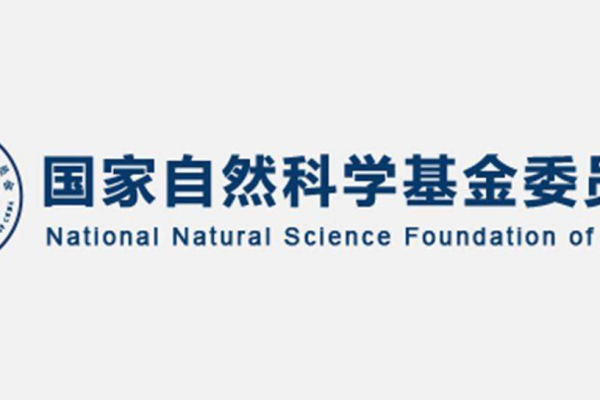Chip发表中国科学技术大学李传锋、周宗权团队综述论文:基于色心和稀土离子与光纤法布里-珀罗微腔耦合的固态量子节点
FUTURE远见| 2024-05-17
Future|远见
Future|远见future选编
近日,中国科学技术大学李传锋、周宗权团队以「Solid-state quantum nodes based on color centers and rare-earth ions coupled with fiber Fabry-Pérot microcavities」¹为题在Chip上发表综述论文,介绍了将光纤法布里-珀罗微腔与色心和稀土离子耦合的最新研究进展及其作为固态量子节点构建量子网络的应用前景。第一作者为孟若然和刘肖,通讯作者为李传锋和周宗权。本文为特刊(Cryogenic Chips)文章之一,此特刊为Chip发起的首个特刊。Chip是全球唯一聚焦芯片类研究的综合性国际期刊,是入选了国家高起点新刊计划的「三类高质量论文」期刊之一。
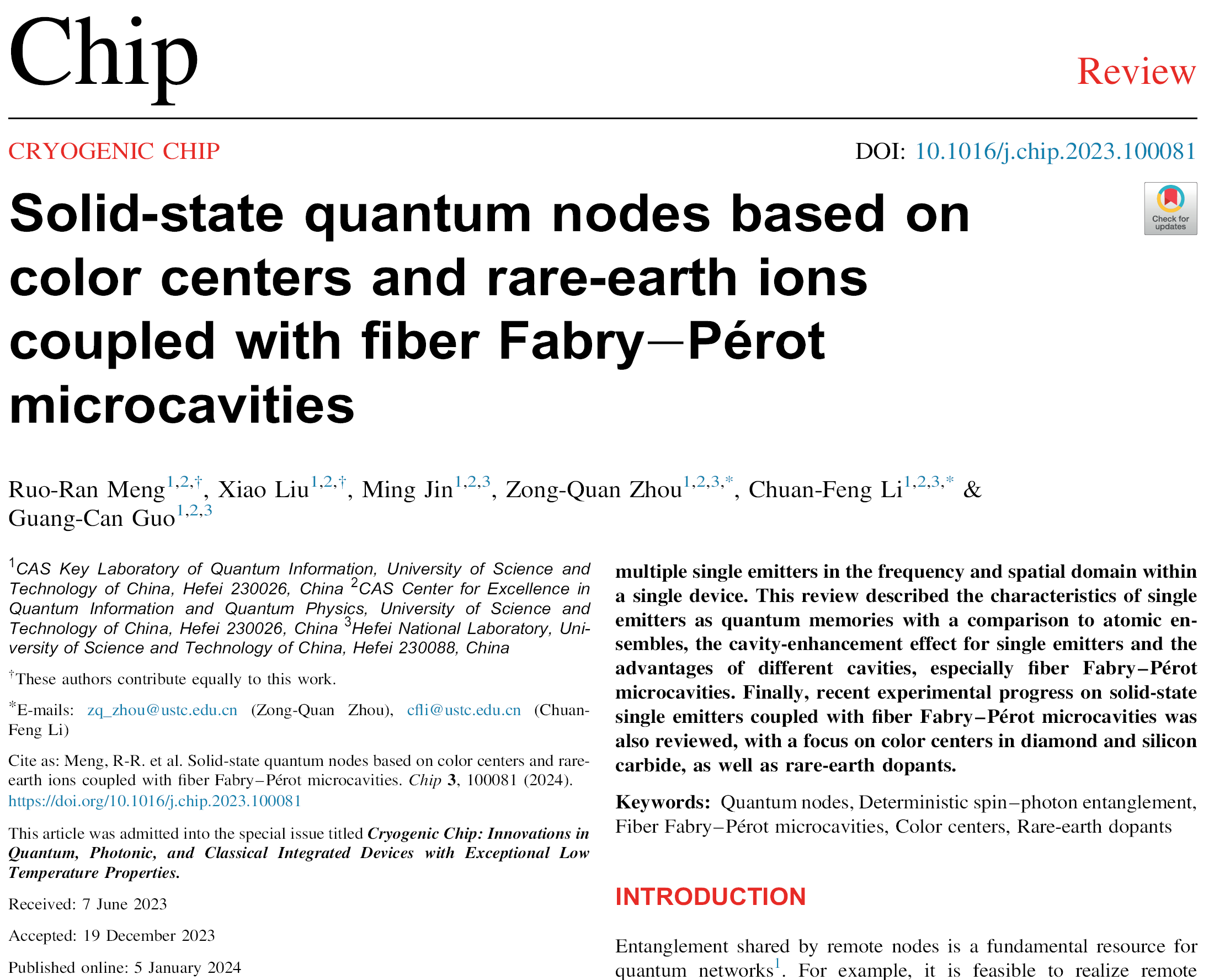
远程量子纠缠是量子网络的基础资源。为克服信道的指数损耗,实现大尺度量子网络,可采取量子中继方案延长纠缠分发的距离²(图1a),也可以将纠缠态存入超长寿命的可移动量子存储器中,进而运输到远程节点³(图1b)。上述方案均需要构建高性能的量子节点,其内部包含用于量子存储的物质比特和用于节点间连接的通信比特。固态单发射体天然囚禁在固体中,具有稳定的物理环境,通过和光学谐振腔耦合,可以大幅提高光和物质的相互作用以及光子的产生效率。这一原子-光学腔耦合系统可以确定性地产生自旋光子纠缠,成为备受关注的量子节点候选物理系统。其中基于色心和稀土离子与腔耦合的单发射体,具有优异的自旋相干性质和光学性质,可以同时满足量子节点内物质比特和通信比特的需求,具有巨大的应用前景,近年来在实验上也取得了重要进展。

图1 | 量子中继和可移动量子存储的示意图。a,量子中继方案,将长距离光纤分段建立纠缠,借助节点内量子存储器的同步和纠缠交换技术,扩展纠缠距离。b,可移动量子存储方案,将纠缠光子存储在超长寿命的可移动量子存储器中,借助火车、飞机、卫星等运输工具,将纠缠态传输到远程节点,进而实现远程量子纠缠分发。
该综述首先介绍了固态单发射体以及常见的微型光学谐振腔,重点分析了光纤法布里-珀罗微腔⁴(图2)的特性及其和单发射体耦合时的优势,包括高品质因数、大调谐范围和易于实现光纤集成等。法布里-珀罗微腔的开放式结构可以兼容纳米颗粒到微米量级薄膜的样品,并且可以耦合远离表面的单发射体,避免表面效应等对光谱展宽的影响。这有助于提高发射光子的不可分辨性,对量子网络中节点间的级联应用非常重要。作者重点回顾了光纤法布里-珀罗微腔耦合固态色心和稀土离子的研究现状⁵⁻⁸,并讨论了未来的发展方向。

图2 | 光纤法布里-珀罗微腔的具体示意图³。a,两个光纤凹面镜构成的谐腔;b,光纤凹面镜和光纤平面镜构成的谐振腔;c,光纤凹面镜和平面镜基底构成的谐振腔。其中c图的结构由于方便放置固体纳米颗粒或薄膜等介质,被广泛用于研究研究各类固态单发射体。
光纤法布里-珀罗微腔与色心的耦合,如金刚石NV(nitrogen-vacancy)色心,可以提高零声子线光子的辐射速率,有助于提高量子节点发射纠缠光子的效率。目前基于光纤法布里-珀罗微腔已实现与金刚石纳米颗粒、薄膜等体系中单色心的耦合和探测⁵⁻⁶,并在4 K低温下观测到腔增强的光子发射。固态体系中的稀土离子在液氦温度下具有更长的相干时间和近乎完美的零声子线,其中铕离子(Eu³⁺)的相干寿命长达六个小时³,铒离子(Er³⁺)的发光在通信波段。将光纤法布里-珀罗微腔与稀土掺杂晶体耦合,可以大幅降低稀土单离子的荧光寿命、提高收集效率,并且可以实现对特定能级的跃迁调控,对研制超长寿命量子存储器以及实现通讯波段的自旋光子纠缠具有重要意义。借助开放式法布里-珀罗微腔,当前在纳米颗粒和薄膜体系中均已探测到通信波段发光的单个稀土饵离子⁷⁻⁸,并展现出频率复用的发展潜力(图3)。

图3 | 低温下开放式法布里-珀罗微腔与固体中稀土离子耦合的最新进展⁷⁻⁸。a,光纤法布里-珀罗微腔耦合稀土掺杂纳米颗粒示意图;b,法布里-珀罗微腔耦合稀土掺杂晶体薄膜示意图,其中凹面镜基底可更换为光纤凹面镜,以获得更小的模式体积和更灵活的光纤集成性能;c,光纤法布里-珀罗微腔中单个铒离子发光的腔增强效应演示;d,微腔与薄膜耦合体系中多个铒离子发射的频率可分辨的荧光谱,可支持频率复用。
该综述最后展望了光纤法布里-珀罗微腔耦合固态色心和稀土离子的发展前景。在量子网络中,不同的应用场景对节点内量子存储和纠缠光子的技术指标有不同的要求。除了发掘不同体系各自的独特优势外,一些共性问题如提升单发射体与腔的耦合强度、发射光子的频率稳定性以及自旋相干性等还需深入研究。除此之外,该综述还讨论了光纤法布里-珀罗微腔的参数优化、低温下的腔长锁定等技术问题的重要性,并分析了利用光纤法布里-珀罗微腔在单设备中实现高密度空间和频率复用的可能性。光纤法布里-珀罗微腔作为一个重要的工具,与色心和稀土离子的高效率耦合以及高度集成化的研究将极大促进高性能量子节点的构建,为大尺度和高速量子网络的实现打下基础。
Solid-state quantum nodes based on color centers and rare-earth ions coupled with fiber Fabry-Pérot microcavities¹
The entanglement shared by remote nodes is the fundamental resource of quantum networks. However, due to exponential channel loss, the distance of entanglement distribution on the ground is limited to a few hundreds of kilometers. To overcome this difficulty, a ground-based quantum communication network can be deployed with the aid of quantum repeaters² (Fig. 1a). An alternative approach that circumvents the use of long-channel fibers is transportable quantum memories³ (Fig. 1b). Both approaches necessitate the construction of high-performance quantum nodes, which contain matter qubits for quantum memory and communication qubits for links between remote nodes. Single-quantum systems based on single emitters can achieve deterministic spin-photon entanglement, greatly simplifying the constructing quantum network nodes. Among them, optically interfaced spins embedded in solid-state systems, such as color centers in solids and rare-earth dopants, are important candidate systems for implementing long-lived quantum memory due to their stable physical properties and robustness to decoherence in scalable and compact hardware. To enhance the strength of light-matter interaction, optical microcavities can be exploited as an important tool to generate high-quality spin-photon entanglement for scalable quantum networks.

Fig. 1 | Schematic diagrams of quantum repeaters and transportable quantum memories. a, The logical framework of a quantum repeater. b, The basic idea of a transportable quantum memory.
In this review article, the authors introduce commonly-used micro-optical resonators and describe the characteristics of single emitters as quantum nodes in comparison to atomic ensembles when coupled to different microcavities, especially fiber Fabry-Pérot microcavities⁴ (Fig. 2). For solid-state systems, fiber Fabry-Pérot microcavities have been demonstrated to be an excellent choice, as they can incorporate micrometer-scale membranes inside the open and tunable structure without damaging the materials and avoid addressing ions too close to the interfaces, thereby preserving the coherence properties of the spins while achieving high cavity enhancement. This review provides a detailed review of recent experimental progress in coupling solid-state single emitters with fiber Fabry-Pérot microcavities, highlighting two promising platforms: color centers in solids and rare-earth dopants.

Fig. 2 | Specific schematic diagram of the fiber Fabry-Perot microcavity³. a, A harmonic cavity formed by two fiber concave mirrors. b, A resonant cavity formed by a fiber concave mirror and a fiber planar mirror. c, A resonant cavity formed by a fiber concave and a planar mirror substrate.
Coupling fiber Fabry-Pérot microcavities with color centers, such as NV (nitrogen-vacancy) centers in diamond, can increase the emission rate at zero-phonon line (ZPL) and decrease the emission rate at phonon sidebands, which contribute to generating quantum entanglement between remote nodes with high efficiency. To date, the coupling between fiber Fabry-Pérot microcavities with single emitters in diamond nanoparticles and membranes have been demonstrated⁵⁻⁶ (Fig. 3), and more importantly, cavity-enhanced single-photon emission at 4 K has been observed. Rare-earth ions exhibit long coherence times and rich optical spectra with nearly perfect ZPL at liquid-helium temperatures. For instance, europium ions (Eu³⁺) have a coherence lifetime of up to six hours³, and erbium ions (Er³⁺) emit photons in the telecom band. Coupling rare-earth ions with fiber Fabry-Pérot microcavities can significantly decrease the fluorescence lifetime, improve collection efficiency, and enable the control of specific optical transitions, which is of great significance for the development of ultralong-lifetime transportable quantum memories as well as the realization of spin-photon entanglement in the telecom band. By utilizing open Fabry-Pérot microcavities, detection of single erbium ions emitting light in the telecom band has been achieved in both membranes and nanoparticles⁷⁻⁸. These works also highlight the potential for multiplexed addressing of single emitters in frequency domain.

Fig. 3 | Recent advances of open rare-earth-ion-doped membranes coupled with fiber F–P microcavities⁷⁻⁸. a, Schematic diagram of fiber Fabry-Perot microcavity-coupled rare-earth doped nanoparticles. b, Schematic diagram of an Er³⁺: YSO membrane coupled with an F–P microcavity. c, Demonstration of cavity-enhanced effect of luminescence of a single Er³⁺ in the fiber Fabry-Perot microcavity. d, Coupling of microcavity with thin film in the coupled system of multiple frequency-resolved fluorescence spectra of Er³⁺ emission.
The review concludes with a perspective on the development prospects of coupling solid-state color centers and rare-earth ions with fiber Fabry-Pérot microcavities, especially in constructing quantum nodes for long-distance entanglement distribution. Within quantum networks, different application scenarios impose different requirements on the technical specifications of quantum memory. Besides exploring the unique advantages of different systems, there are common challenges that require further investigation, including enhancing the coupling strength between single emitters and cavities, improving the frequency stability of emitted photons, and maintaining spin coherence. Additionally, the review highlights the importance of addressing technical issues such as optimizing the parameters of fiber Fabry-Pérot microcavities and stabilizing cavity length at cryogenic temperatures. Finally, the review provides an outlook on the miniaturization and integration of high-density emitters within a single fiber-based cavity-coupled device. Fiber Fabry-Pérot microcavities, as an indispensable tool for the study of efficient quantum nodes based on solid-state color centers and rare-earth dopants, will greatly promote the construction of high-performance quantum nodes, and lay a foundation for the realization of large-scale and high-speed quantum networks.
参考文献:
1. Meng, R-R. et al. Solid-state quantum nodes based on color centers and rare-earth ions coupled with fiber Fabry–Pérot microcavities. Chip 3, 100081 (2024).
2. Briegel, H.-J., Dür, W., Cirac, J. I. & Zoller, P. Quantum repeaters: the role of imperfect local operations in quantum communication. Phys. Rev. Lett. 81, 5932 (1998).
3. Zhong, M. et al. Optically addressable nuclear spins in a solid with a six-hour coherence time. Nature 517, 177–180 (2015).
4. Hunger, D. et al. A fiber Fabry–Pérot cavity with high finesse. New J. Phys. 12, 065038 (2010).
5. Kaupp, H. et al. Purcell-enhanced single-photon emission from nitrogen-vacancy centers coupled to a tunable microcavity. Phys. Rev. Appl. 6, 054010 (2016).
6. Ruf, M., Weaver, M. J., van Dam, S. B. & Hanson, R. Resonant excitation and Purcell enhancement of coherent nitrogen-vacancy centers coupled to a Fabry-Pérot microcavity. Phys. Rev. Appl. 15, 024049 (2021).
7. Ulanowski, A., Merkel, B. & Reiserer, A. Spectral multiplexing of telecom emitters with stable transition frequency. Sci. Adv. 8, eabo4538 (2022).
8. Deshmukh, C. et al. Detection of single ions in a nanoparticle coupled to a fiber cavity. Optica 10, 1339–1344 (2023).
论文链接:
https://www.sciencedirect.com/science/article/pii/S2709472323000448
作者简介

孟若然,中国科学技术大学未来技术学院2023级在读博士研究生,主要研究方向为固态量子存储。
Ruo-Ran Meng is a Ph.D. student at the School of Emerging technology of University of Science and Technology of China (USTC). His research focuses on solid-state quantum memory.
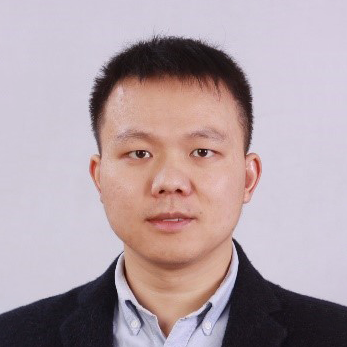
刘肖,中国科学技术大学中科院量子信息重点实验室副研究员,2019年在中国科学技术大学取得博士学位,主要研究方向是固态量子存储和量子中继的研究。
Xiao Liu is an associate researcher at CAS Key Laboratory of Quantum Information, University of Science and Technology of China (USTC). He received his Ph.D. degree from USTC in 2019. His research interests focus on solid-state quantum memories and quantum repeaters.
关于Chip
Chip(ISSN:2772-2724,CN:31-2189/O4)是全球唯一聚焦芯片类研究的综合性国际期刊,已入选由中国科协、教育部、科技部、中科院等单位联合实施的「中国科技期刊卓越行动计划高起点新刊项目」,为科技部鼓励发表「三类高质量论文」期刊之一。
Chip期刊由上海交通大学出版,联合Elsevier集团全球发行,并与多家国内外知名学术组织展开合作,为学术会议提供高质量交流平台。
Chip秉承创刊理念: All About Chip,聚焦芯片,兼容并包,旨在发表与芯片相关的各科研领域尖端突破性成果,助力未来芯片科技发展。迄今为止,Chip已在其编委会汇集了来自14个国家的69名世界知名专家学者,其中包括多名中外院士及IEEE、ACM、Optica等知名国际学会终身会士(Fellow)。
Chip第三卷第一期已于2024年3月在爱思维尔Chip官网以金色开放获取形式(Gold Open Access)发布,欢迎访问阅读本期最新文章。
爱思唯尔Chip官网:
https://www.sciencedirect.com/journal/chip

